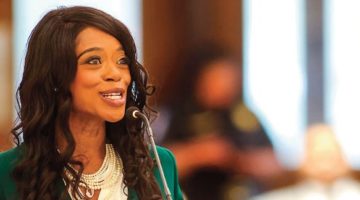 Special to South Florida Times
Special to South Florida TimesThe city of Fort Lauderdale honored the legacy of civil rights activist Eula Gandy Johnson and the 50th year anniversary of the end of beach segregation this week. A ribbon-cutting ceremony was held at the Eula Johnson House, 1100 Sistrunk Blvd. in Fort Lauderdale. The program was a part of the city’s year-long centennial celebrations.
The newly renovated building, once Johnson’s private home where she owned and operated a gas station out front, will now serve as the Fort Lauderdale/Broward Branch NAACP headquarters as well as a museum and welcome center for residents, visitors, existing and prospective business owners who visit the historic Sistrunk Corridor.
Known by many as the Rosa Parks of Broward County, Johnson, the first woman president of the local NAACP, made history on July 4, 1961 when she, along with Dr. Von Mizell and a group of black students from Dillard High School became the first blacks to wade into the segregated waters of Fort Lauderdale beach.
Meetings to organize the wade-ins were held in secret in Johnson’s home, according to local NAACP president Marsha A. Ellison. “The secret had to be kept because even carrying a NAACP card could have meant death. A lot went on in that little house,” she said.
The six-week series of wade-ins brought national headlines. The city of Fort Lauderdale later sued Johnson for being a public nuisance. A federal court ruled in her favor and against the city’s segregation policies.
Five years after Johnson’s death in 2001, her grandson, Gregory Johnson, sold her home to an absentee owner who allowed it to deteriorate. In 2008, the Community Redevelopment Agency (CRA) acquired the property for $165,000, according to Fort Lauderdale City Commissioner Bobby DuBose.
The property is currently owned by the City of Fort Lauderdale and the NAACP will have a no-cost lease on the facility with the CRA for an initial term of 50 years, with the NAACP responsible for day-to-day maintenance.
“People are asking why the City of Fort Lauderdale is spending money on such a small house,” said DuBose. “It’s about more than brick and mortar; it’s about our community, our history, and what has been endured.”
DuBose said that Johnson was a “woman who simply wanted to visit Fort Lauderdale Beach without the fear of being arrested for just being black.”
It was ironic, having a female to stand in those times, Adora Obi Nweze, president of the Florida State Conference, NAACP, said. “Can you imagine during that era that they would have the nerve to step up and speak out, not in fear of their very lives? It was bad enough for men, but for women, it was unheard of.”
No other NAACP branch in Florida has this kind of memory, Nweze said. “No other branch in this state has written this kind of history. Even though they have lived it, they have not recorded it.”
There were a lot of people involved in the wade-ins, a lot of support, Gregory Johnson, Eula Johnson’s grandson said. “I was really afraid for her. We had been getting threatening phone calls; I guess that was something I should have been used to, but I wasn’t.”
Gregory, who lives in Tallahassee, said Johnson took him in at 6 months old and raised him as her own.
There were several attempts made by whites to buy Johnson off, Gregory said during an earlier interview. Johnson was promised that she would be allowed to shop in certain places, eat in certain restaurants, have access to clubs, and use the front doors at some establishments if she gave up fighting for blacks and quit the Civil Rights Movement.
“Her response was always the same: ‘I’ll come in the front door when I can come in with my people.’”
Johnson was also instrumental in getting people jobs at Winn-Dixie, according to her daughter, Albertha Johnson, of Jacksonville. “They weren’t hiring blacks and she fought to change that; she hated Jim Crow. She was fearless, and I was often afraid for her.”
After the ceremony, the crowd was shuttled to Fort Lauderdale Beach, where a historical marker at A1A and Las Olas Boulevard was posted. The location marked the area where Johnson and Mizell first led a small team of protestors onto white-only beaches.
Fort Lauderdale resident and business owner George Burrows, 85, described Johnson as “quite an asset to this community. She really deserves more than what we are giving her. She left quite a legacy for us to follow.”
Johnson died at 94 in 2001, but her words reverberated during the ceremony as an oral history she recorded before her death was played: “Fear is a mean monster. I asked God to take the fear away from me. Fear is what kept black people down.”
Cynthia Roby can be reached at CynthiaRoby@bellsouth.net
Photo by: ALAN LUBY/FOR SOUTH FLORIDA TIMES
HISTORIC MOMENT: Gregory Johnson, left, grandson of Eula Johnson, cuts the ribbon on Monday to dedicate the Eula Johnson House, 1100 Sistrunk Blvd., Fort Lauderdale, as a museum in her memory. Those witnessing the event included, from left, Bobby B. DuBose, vice-mayor of Fort Lauderdale; Marsha A. Ellison, president of the Fort Lauderdale/Broward NAACP; and John "Jack" P. Seiler, mayor of Fort Lauderdale.












No Comment